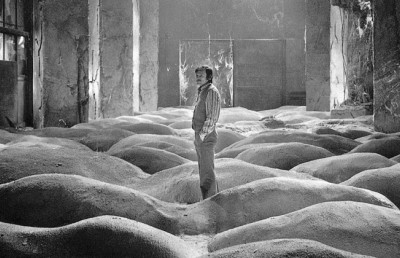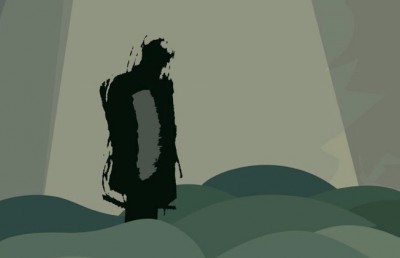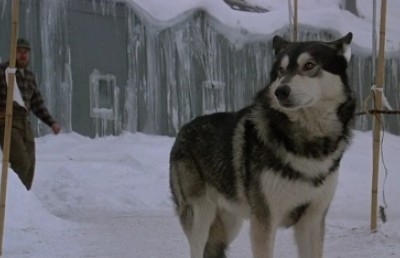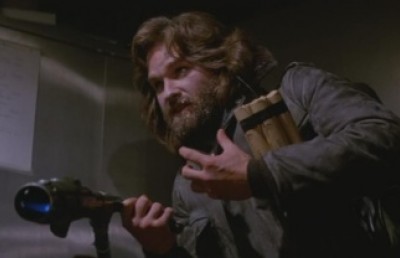Against Demonologies: Character, Cognition, and Circumstance in Z for Zachariah and The Martian
Astrophysicist Neil deGrasse Tyson and writer Samuel Delany’s insights illuminate science fiction
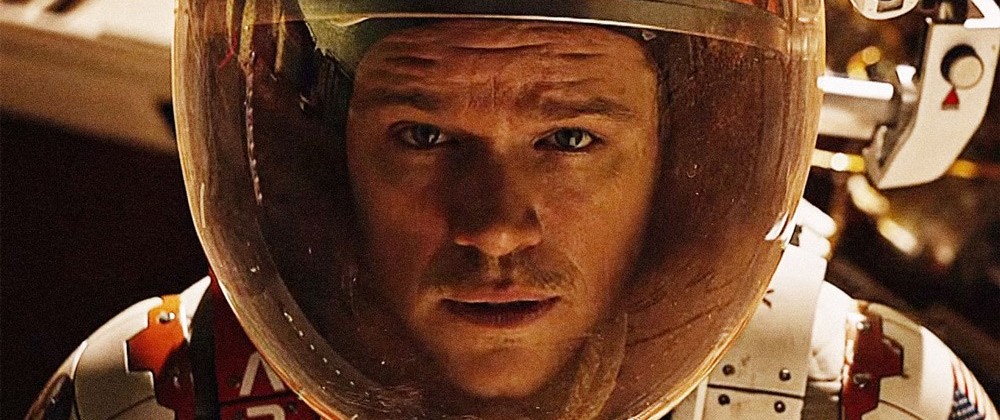
“Inspiration is never at variance with information; in fact, the more information one has, the greater will be the inspiration.”
—George Washington Carver, “A Real Chemist?,” George Washington Carver: A Life
“Literature—whether a particular piece right through here is being judged minor or major—will reflect just about anything you want to read into it…if you read intensely and intelligently enough. So will paraliterature. That’s why texts are unmasterable. I’m tempted to say that’s how they’re unmasterable, too.”
Samuel Delany, “Science Fiction and Criticism,” Silent Interviews
Z for Zachariah has the beautiful, measured look and tone of a thoughtful drama; and its story, an imagined epilogue to a history of complexities and conflict, appears simple and poignant, although its assumption of devastation is profound: there seem to be no nations, governments, cultures, or institutions—all is remembrance and ruin, remnants. Through the desolation of an American town in a destroyed world, a solitary figure walks, sheathed in layers, scavenging books and supplies, with a meter for radiation detection. She is a young woman, a farm girl, living in a surprisingly green valley, a small patch of world that has not been annihilated. She, Ann Burden, works hard, growing vegetables and tending chickens and cow and making farm repairs, but she is lonely, with no more than her dog for company, whom she talks to, as if beginning to go mad. The pale farm girl Ann Burden sees a stranger’s wagon: the dark-skinned stranger is in a special protective white suit, and exults at finding verdant land—and he, John Loomis, jumps into a secluded pool of water, not knowing the water comes from outside the lushly green valley and is poisoned. The young woman, although the two are first frightened of each other, helps John Loomis recover from his toxic reaction, nursing him. He, John, is weak, sick; and she, Ann, scrubs him, puts him to bed, giving him food and medicine.
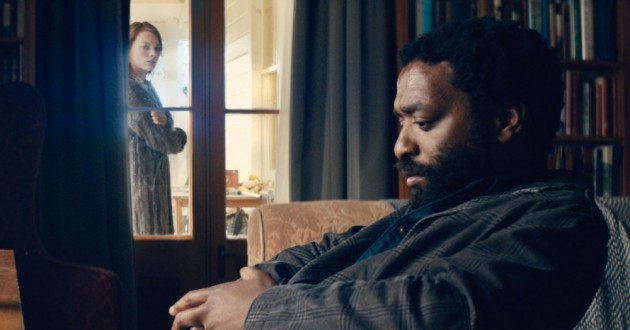
How to live alone? How to live with others? The cinema work Z for Zachariah, like The Martian, is about survival. There is in Z for Zachariah no distraction, noise, false spectacle, no vulgarity: it allows its characters their world, without pandering. In the motion picture Z for Zachariah (2015), directed by Craig Zobel and photographed by Tim Orr, with a screenplay by Nissar Modi based on the fiction of Robert C. O’Brien, Ann Burden’s family home is full of life’s accumulations; and now with the arrival of Mister John Loomis, a research scientist, Ann is no longer alone, no longer dependent only on the family chapel for solace and her dog for company. Ann (Margot Robbie), who continues her chores of milking the cow and turning crop ground, prays for John’s survival—for herself as much as for him. When they talk, Mr. Loomis (Chiwetel Ejiofor), a research scientist, tries to find a scientific explanation for the valley’s health, considering the placement of the valley—Ann believes the valley’s health is due to divine providence (and an underground aquifer). The two are different in intellectual and spiritual beliefs (there are differences as well of in age, gender, and skin color); but they develop easy routines together. John Loomis goes through books in her large library. Observation and conversation, as well as reading, are methods of learning. John instructs Ann in how to retrieve gas from a nearby store pump without using electricity. Each remains somewhat lonely despite their growing friendship; and there seems some sexual curiosity.
What is John, a research scientist, looking for in Ann’s library? There might be practical questions about radiation and self-protection, and more general questions about building a sustainable life now that he, too, must be a farmer. Will John be able to use his expertise in his new life? Science, like art, is one of the elemental impulses of human beings: curiosity, intelligence, and the desire (and need) to know are the beginning of knowledge; and science is the system we discover in, or impose on, what we have learned, questioning, testing, verifying. There is proof of the desire to know in a child’s play and speculations, and in elders entering the wilderness again to see what they might find. There is proof of the desire to know on ancient cave walls and in old things found long after their use; and in the remains of old Mesopotamia, Babylon, and Egypt. The ancient Greeks thought about the world they saw above and around them, and the Greeks began to articulate theories to explain the universe and the human world, giving us a treasury of philosophy as well as mathematics, mechanics, and botany. Other cultures—in China, India, and Baghdad made their contributions too, in math and in inventions; in language and number systems; in cultural translations. We are inheritors. John Loomis is the child and the elder—the seeker.
Science is the discovery of laws in nature, the identification of proven principles, and the articulation of explanatory theories of practice and process rooted in logic and observation: science is organized knowledge. In Z for Zachariah, John Loomis, a research scientist, a man used to gathering knowledge, conducting experiments, and developing programs and products, begins to repair the farm generator, and he imagines creating a water wheel that could manifest energy to power the generator (a hydroelectric generator), proposing he and Ann tear down the family chapel for the wood needed to make the wheel, something Ann does not want to do. What is required for civilization? Friendship? Technology? Morality? The pastoral peace of Ann (Margot Robbie) and John (Chiwetel Ejiofor) is broken first when John gets drunk and rebuffs Ann’s attempts to help him disrobe for bed, and then when a young man arrives. The young man, Caleb (Chris Pine), dirty and disheveled, strong and wily, arrives after white fog and mist rise over the land; and he—apparently, a local man and a mine worker, is not educated, and Caleb and Ann seem to share traditional religious faith (and Caleb is white, like Ann, unlike the brown-skinned John). John and Caleb each survived because he was underground when catastrophe occurred; and each tell stories of the violence that accompanied the disaster, but each telling seems to leave something out—something about their own desperation and survival instinct and violence.
Skepticism is a fundamental part of science—but human relationships cannot be built on skepticism, and require compassion and faith, imagination and intuition. Ann talks to John about the difficulties of being alone, of how John’s presence has helped her. The three, Ann, John, and Caleb, talk and eat and drink together. The movements of John and Caleb as they hunt turkey is ambiguous—and Caleb’s joke about Ann as prize for the best hunter is ominous. Caleb is both ingratiating and cunning. Caleb supports John in tearing down the chapel for the proposed water wheel, for the generator. Caleb tells Ann that the church was only holy because of what she brought to it: her faith, her devotion, made it holy. Which one of the men will be the new Adam: Caleb or John? John sees the growing attraction between Ann and Caleb and initiates a talk with Ann about it, saying she should take her time to figure out what she feels for each man—John is honest, intelligent, bitter, and funny when doing that: “You all go on and be white people together,” John says, a frustrated anger overwhelming his impulse at generosity, as if old systems of being and thinking have returned with the while male Caleb. Ann looks shocked. The three work well together, but (emotional, erotic) tensions increase. Loomis gives Ann awareness, purpose—Caleb gives her experience. John confesses his love, but that may be too late—John is a formidable thinker but a vulnerable man.
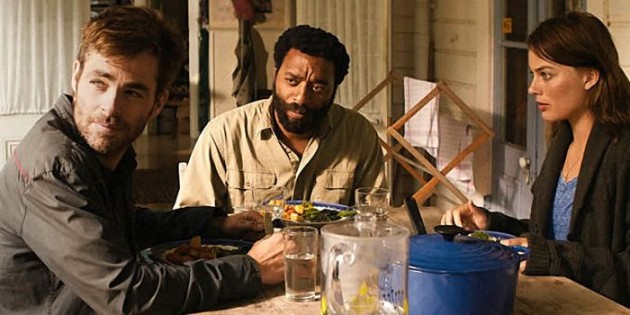
Caleb (Chris Pine), John Loomis (Chiwetel Ejiofor), Ann Burden (Margot Robbie)
Science exorcised much of the world’s belief in demons and witches, but the belief in angels and gods persists—as does the hope for our own transcendence. What is the power of knowledge when it comes to love? What do the microscope, the telescope, and the thermometer have to say of affection and desire? Could even a stethoscope set to the pulsing of the heart be of use? What do the thought experiments of Galileo—or of scientists and inventors such as Robert Boyle, Christian Huygens, Isaac Newton, Evangelista Torricelli, and Otto von Guericke or Gottfried Wilhelm von Leibniz—have to do with passion and jealously, or with the desire to survive and then to leave a legacy? However science and technology have affected the lives of people such as Ann, John, and Caleb—through discovery of the atom or the articulation of the theories of evolution, quantum mechanics, relativity, or uncertainty—science and technology have their limits when it comes to emotion. Emotion is often the felt sum of experience and thought, of instinct and impulse; and often intense emotion has no relief but sex or violence. The compassion and courage and discipline and faith and imagination and intellect and stamina required—of those who “seeking a now that can breed / futures / like bread in our children’s mouths / so their dreams will not reflect / the death of ours” as the poet Audre Lorde declared in “A Litany for Survival,” published in her book The Black Unicorn (W.W. Norton, 1978)—will come from within, and virtues are often challenged from without. Yet, work is what Z for Zachariah’s three isolated people do, whatever they feel: they create a necessary and even transcendent project. The water wheel the three build functions, and functions well, giving power to the generator, and the house has electricity, but the film’s conclusion has ambiguities of different kinds. Does civilization require a sacrifice—of life, of grief, of judgment—for its foundation? Is morality built on the knowledge of crime and guilt not as possibilities but as facts? Will John Loomis be the new Adam, the first man, or the last man, a Zachariah?
The 2015 motion picture Z for Zachariah is not the same story as the book by Robert C. O’Brien (real name Robert Leslie Carroll Conly) that inspired the film: published in 1974, the novel Z for Zachariah, a winner of the Edgar award (a Mystery Writers of America prize) by an author who had won a Newbery award (for the children’s work Mrs. Frisby and the Rats of NIMH), suggests that the conflicts that created a toxic atmosphere—a one-week war, a nuclear cataclysm—also exists in the two very different people who have survived, the pale-skinned and radiation-poisoned Mr. Loomis and the healthy Ann Burden, a demanding man and a sweet girl whose values are in conflict despite her care for him during his lengthy convalescence. (Ann, a youthful lover of literature, may be more crafty, more feisty, and more shrewd in the book Z for Zachariah than she is in the film, and less forgiving—and the experienced man of science, Loomis, less manipulative and malicious in the film than in the book; and there is more than one forceful physical confrontation between the two in the book, in which Loomis takes control of Ann’s property.) The book Z for Zachariah, which takes principled survival as its theme, was celebrated for the maturity and strength of its imagination: and, it had been completed by Robert O’Brien’s wife Sally Conly and daughter Jane Leslie Conly, following his death and using his notes, and published posthumously; and, even in light of the principal author’s previous accomplishment, one imagines that it benefited from that collaboration as well as from the centrality of the woman character as an ethical presence. (Is the book’s Mr. Loomis a demon portrait of a controlling scientist, something that recurs in fiction and film as warnings, someone inadequately humane?) In the book’s depiction of the fundamental conflicts between personalities, perspectives, and philosophies—dominance versus collaboration, science versus art and spirituality—the book, a work of imagination and moral conscience, is compelling in its contemplation of differences that may be escapable in human nature and human society.
It is likely that the book Z for Zachariah was born of the atmosphere that existed after World War II, the cultural climate that gave the world literary and philosophical existentialism (that is, the anxious desire for personal agency and choice and their public representation); the mass industrialization of modern life, with and the loss of folk cultures as well as diminished sense of personal control; the atom bomb (and fear of nuclear annihilation); the political cold war between America and Europe on one side and the Soviet Union (Russia) and the communist nations on the other. What would become of the individual; and what would become of society? There certainly had been other books that considered an apocalypse: while Mary Shelley (The Last Man, 1926) and Edgar Allen Poe (“The Conversation of Eiros and Charmion,” 1839) may have considered the destruction of society and world before the harnessing of atomic energy for destructive purposes, the demonstrations in Hiroshima and Nagasaki made the matter a real possibility—one that writers such as Ray Bradbury (Fahrenheit 451, 1953) and Pat Frank (Alas, Babylon, 1959), among others, pursued: The book Nuclear Holocausts: Atomic War in Fiction, a study by Paul Brians published in 1987, considers nearly one hundred years of works—literature published between 1895 and 1984—and that study documents what a rich subject this has been. Although the character of John Loomis has been softened in his translation from book to film, the casting of the character has produced a new charge and a new hope in the depiction of a devastated world: Loomis is played by Chiwetel Ejiofor, one of the best black British actors, along with Idris Elba, John Boyega, Alfred Enoch, Lennie James, Peter de Jersey, Adrian Lester, David Oyelowo, and Colin Salmon. One of the very best actors of our time. Ejiofor has a somber, thoughtful, warm quality—but, like Matt Damon, he is capable of believable ferocity. Chiwetel Ejiofor has appeared in Amistad, Children of Men, Dirty Pretty Things, Endgame, Melinda & Melinda, and Secret in Their Eyes as well as 12 Years A Slave and Half of a Yellow Sun. Ejiofor is of Nigerian (Igbo) descent, the son of a doctor and pharmacist, and his casting as John Loomis adds another level of interpretation, one involving the history of race in the western world in general and in America in particular, but the film Z for Zachariah cannot be said to be about that. Will the world that is reborn be different, or the same as before?
“I sit with Shakespeare and he winces not. Across the color-line I move arm in arm with Balzac and Dumas, where smiling men and welcoming women glide in gilded halls. From out the caves of evening that swing between the strong-limbed earth and the tracery of the stars, I summon Aristotle and Aurelius and what soul I will, and they come all graciously with no scorn nor condescension,” wrote the activist, educator, philosopher, and writer W.E.B DuBois, in an essay on the necessity of educating blacks not only for vocation but for full citizenship, “On the Training of Black Men,” a chapter in The Souls of Black Folk (original publication, 1903; subsequent publication Gramercy Books, 1994; page 83 and 84). Yet, it took some time before people of color, particularly Negroes, became a regular presence in science fiction films. There have been, beside Z for Zachariah and The Martian, other science fiction films featuring blacks, such as AEon Flux, After Earth, Attack the Block, Avatar, The Book of Eli, Brother from Another Planet, Children of Men, Contact, Deep Impact, District 9, Event Horizon, The Fifth Element, Independence Day, Interstellar, The Matrix, Men in Black, the Pitch Black series, The Signal, Star Wars (The Empire Strikes Back), Star Trek, Strange Days, Virtuosity, White Man’s Burden and The World, the Flesh and the Devil. Most of those films do not take racial categorization or racial prejudice as a subject. However, it is impossible not to think of race when considering the 1959 black-and-white motion picture The World, the Flesh and the Devil and the more recent Pitch Black series.
The film The World, the Flesh and the Devil (1959), a film directed by Ranald MacDougall and photographed by Harold J. Marzorati, featured Harry Belafonte as the Pennsylvania miner Ralph Burton, one of the few survivors of a nuclear war, in a film co-starring Inger Stevens as Sarah Crandall and Mel Ferrer as Benson Thacker, fellow survivors Belafonte’s Ralph meets in New York. (The film’s sources were Matthew Phipps Shiel’s novel The Purple Cloud and Ferdinand Reyher’s story “End of the World.”) Ralph is an admirable man, a man of strong character and imaginative resource, one the blonde Sarah respects and likes. Despite the perceptible sexual attraction of the Ralph and Sarah, their relationship does not develop—and although she inspires competition between (brown) Ralph and the more amoral (white) Benson, the film ends with the three still together.

Caleb and Ann in Z for Zachariah
The World, the Flesh and the Devil is a very polite film, in terms of racial conflict—but the Pitch Black trilogy—Pitch Black (2000), The Chronicles of Riddick (2004), and Riddick (2013)— presents a central character, Riddick (Vin Diesel), who has a criminal reputation: Riddick is very much someone who is seen as other—other than like us, other than decent, a man dark, dangerous, and not worthy of trust—although when great dangers arise, Riddick proves himself, and, subsequently, his transgressions, when described or explained by him, are understandable, if not fully acceptable. The actor Vin Diesel is the son of a mother with British ancestry and a mysterious father (and an African-American stepfather), and Diesel has a face that reads as being of ambiguous ancestry, though possibly as black; and Diesel’s darker-than-white Riddick is being transported to a prison in the first film Pitch Black, written with the Wheat brothers by its director by David Twohy. When the cargo spaceship Riddick is on crashes on a desert planet, and his ingenuity and strength are needed to save the others from carnivorous flying night beasts, Riddick’s social value, once denied, is established. The second film, The Chronicles of Riddick, written and directed by David Twohy, involves Riddick’s escape from captivity and encounter with a death cult (the cult seems to blend twentieth-century German fascism with twenty-first century Arab Islamic terrorism, featuring colonizing philosophy and practices, cruel shock-and-awe tactics, and destructive, monumental statuary); and the second feature has more esoteric ruminations on spirituality and power than the first and a more heroic Riddick, one who wins a high status. The third film Riddick, written and directed by David Twohy, bears narrative similarities to the first, involving Riddick’s abdication of public responsibility and finding himself on a planet that seems barren but for its assorted dangers, several species of large, violent creatures. The series is worth seeing for its sure sense of adventure and surprise, for its compelling tone, and for observing how Riddick is criticized and suspected of the worst of human behavior before proving himself smart, tough, and admirable, the most necessary of men. Riddick repudiates the assigned demonology while maintaining some of the fierce traits that frighten. The film Z for Zachariah, in comparison, offers a rather mellow portrait of intimacy and choice, with only suggestions of something darker.
Z for Zachariah, then, is a piece of speculative fiction in film: What happens when much of civilization has been destroyed, its manners and its forms as well as its utilities? What will we do then? It is a classic situation for science fiction, which has been concerned, very frequently, although not always, with matters of act or event and consequences, drawing on attitudes and feelings, philosophy and morality, and factors of commerce and power as part of its themes. Often fundamentals—time and space—are thrown in doubt. Often it is catastrophe that reveals character and allows for invention. Often strange creatures, human or alien, are born or emerge. Some have said that speculative fiction has old beginnings—in the Epic of Gilgamesh and the ancient second-century writer Lucian of Samosata’s True History and Thomas More’s Utopia (1516); others cite more modern writings such as Mary Shelley’s Frankenstein (1818) and Jules Verne’s Journey to the Center of the Earth (1864), as well as the work of H.G. Wells in the late 1800s (Wells’ The Time Machine, 1895; Island of Dr. Moreau, 1896; The Invisible Man, 1897; and War of the Worlds, 1898), and the writings of C.S. Lewis, Matthew Phipps Shiel, and Olaf Stapleton. However, the speculative fiction that takes as its objects of contemplation science and technology, and prospects for the future, and is known to many as science fiction, is more frequently dated to 1926, when Hugo Gernsback used the term “scientifiction” which became shortened to science fiction. Aldous Huxley’s Brave New World (1932), George Orwell’s 1984 (1949), Arthur C. Clarke’s Childhood’s End (1953) and the work of Robert Heinlein, Isaac Asimov, and Ray Bradbury are all part of the foundation of the expansive genre: a genre that dramatizes the structures and processes of worlds—and their destruction and rebuilding.
“If science fiction were definable, then it would be the only genre that was!” declared the visionary writer Samuel Ray Delany, Jr., denying that absolutely necessary and sufficient conditions had been articulated for science fiction, in his Diacritics interview “Science Fiction and Criticism,” collected in his anthology Silent Interviews: On Language, Race, Sex, Science Fiction, and Some Comics (Wesleyan University Press, 1994; page 192). Silent Interviews is an assortment of written interviews with Delany on speculative fiction focused on the human world and its engagement with myth and philosophy as well as science and technology, the future, social issues, and cultural criticism; written rather than spoken interviews, some of them conducted by colleagues and friends, that were commissioned by, or first appeared in, journals such as Science Fiction Studies, Camera Obscura, and Diacritics. Samuel R. Delany describes excess as a marker of the aesthetic text—excess in beauty, excellence, and insight: the text moves beyond function in its pursuit of expression. Samuel Delany thinks, and says, in a Science Fiction Studies interview with Sinda Gregory and Larry McCaffery (“The Semiology of Silence”), that sentences and texts work by shared code; and Delany makes a distinction between literature (mainstream/mundane) and paraliterature (science fiction and minority literatures), while acknowledging the relation—the reaction—each bears the other. The shared code of a genre is both recognizable and changing. Whereas other writers and critics attempt to make science fiction a classical tradition by citing long-ago writers such as Lucian or Thomas More, Delany insists that the tradition goes back only to Hugo Gernsback circa 1926—and, also, Delany recalls how limiting aspects of the field when publishers insisted science fiction see as its audience the mythical ordinary American as represented by the housewife in Nebraska.
Some significant science fiction writers would introduce ideas and issues that would rattle and shake the middle-American housewife: J.G. Ballard, William Burroughs, Thomas Disch, Harlan Ellison, Ursula LeGuin, Joanna Russ, and James Tiptree Jr., writers who presented shocks of reality and transgression in their imaginings. The ordinary middle-American housewife might have been shaken sooner had she read much African-American fiction of any kind. Whereas there have been recognized African-American writers of speculative fiction since the mid-nineteenth century such as Martin Delany and Charles Chestnutt, W.E.B. DuBois, Sutton Griggs, Frances Harper, Pauline Hopkins, and George Schuyler, it was the second half of the twentieth century that brought to the fore science fiction luminaries such as Octavia Butler and Steven Barnes, Tananarive Due, Nalo Hopkinson, John Ridley, and Samuel R. Delany, Delany being the most inventive and philosophical of them all. Samuel R. Delany’s books include The Jewels of Aptor, The Fall of the Towers, The Ballad of Beta-2, Babel 17, The Einstein Intersection, Dhalgren, Stars in My Pocket like Grains of Sand, and Return to Neveryon. Delany has written theoretical criticism as well as pornography. Who else is likely to discuss Antonin Artaud, Jane Austen, Roland Barthes, Walter Benjamin, Hart Crane, Anthony Davis, Jacques Derrida, Thomas Hardy, Robert Mapplethorpe, Joyce Carol Oates, Martha Reeves and the Vandellas, Joanna Russ, Richard Wagner, and Ludwig Wittgenstein?
Samuel R. Delany is a provocative master of writing, and he was once a precocious boy—and his memoir of his early life is The Motion of Light in Water: Sex and Science Fiction Writing in the East Village, 1957 – 1965, (William Morrow/Arbor House, 1988): an intimate, philosophical, and social history of a very particular writer—an extremely intelligent and visionary American, a black, bisexual/gay writer of science fiction and criticism, a writer who both claims and critiques received cultural and political categories (“Look, I am black. Therefore what I do is part of the definition, the reality, the evidence of blackness,” Delany has stated, insisting on complexity, whatever the perceived contradictions; Silent Interviews, page 51). Samuel Delany, a broad and voracious reader, with an interest in drama, music, and science, went to the Dalton School and the Bronx High School of Science (and Camp Woodland and Breadloaf); and at Bronx Science the average IQ was 140 and there Delany met some wonderfully smart and eccentric people, including Marilyn Hacker, who would become his wife and the mother of his child. Samuel Delany read W.H. Auden, Albert Camus, Robert Duncan, William Faulkner, Allen Ginsberg, Marcel Proust—he read everything; and some of Delany’s earliest influences seemed to have included Robert E. Howard, Frank Yerby, and Theodore Sturgeon as well as literary entertainers and innovators past (by age fifteen Delany was bored by H.G. Wells and Jules Verne). Samuel Delany began writing novels when young—publishing the first at twenty. Of course, Delany would enlarge the vision of speculative fiction texts with philosophy and interpretation as well as transgressions regarding class, ethnicity, gender, and sexuality. “You assume there is a traditional way of writing science fiction…You may be confusing a way of reading with a way of writing,” Delany suggests in a written interview with Takayuki Tatsumi for the journal Diacritics (“Science Fiction and Criticism,” Silent Interviews; page 201).
“Literature is a marginal, strategic, and subversive activity at play in the social margins of politics, industry, advertising, and the media, and the minor literatures are, of course, on the margin of the margins,” stated Delany in “Science Fiction and Criticism,” the Diacritics journal interview (Silent Interviews; page 212). He has a way of seeing that is exciting, for being truthful and transformative. Delany insisted, “Minor literatures become privileged in that their situations refract, explain, and finally control the larger literary conditions, which they analyze literature down into…As soon as we admit, by whatever figural means, our bias as real and living writers, we become minor, of course” (page 212).
Funnily enough, it is not only the exact terms of science fiction that may be in doubt—sometimes it is science itself. Skepticism is necessary for good science, asserts the astrophysicist and Hayden Planetarium director Neil deGrasse Tyson and his co-writer Donald Goldsmith in the book Origins (W.W. Norton, 2004): the scientific profession and its studied processes and publications require skepticism, require questioning, as self-criticism and self-correction are necessary for scientific ethics and scientific progress. Brian D. Earp, a research associate at Oxford and a visiting scholar at the Hastings Center Bioethics Research Institute, has written of the questionable circumstances and fallibility of scientists. Brian D. Earp specified problems of concern and effect, not only the typical human matter of a scientist being subject to his own vanity, prejudice, or sheer exhaustion, but also the challenging professional demand of an academic scientist that (s)he publish or risk perishing; and the fact that, in articles for publication, scientific proofs can be flubbed. Scientific articles can be flawed when an author or authors cite as proof faulty and controversial studies, without acknowledging the recorded doubt of other scientists; and, also, when the praising specified studies without examining the applicable materials. Data is sometimes taken out of the appropriate context, and applied that to a different context. There is also the creation of a literature, through published letters to journals and general year-end review articles, supporting a questionable position or medical procedure that is backed by assertion but little or no evidence, without rigorous argument or valid evidence. “There is a veritable truckload of bullshit in science. When I say bullshit, I mean arguments, data, publications, or even the official policies of scientific organizations that give every impression of being perfectly reasonable — of being well-supported by the highest quality of evidence, and so forth — but which don’t hold up when you scrutinize the details. Bullshit has the veneer of truth-like plausibility. It looks good. It sounds right. But when you get right down to it, it stinks,” wrote Brian D. Earp, affirming both the significance of science and the potential flaws in its literature, in the article “The Unbearable Asymmetry of Bullshit,” for the online site Quillette (February 15, 2016).
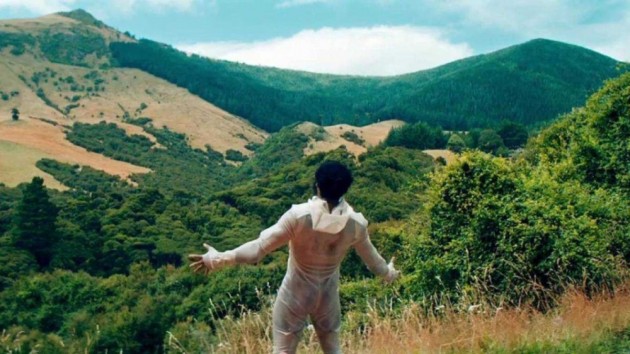
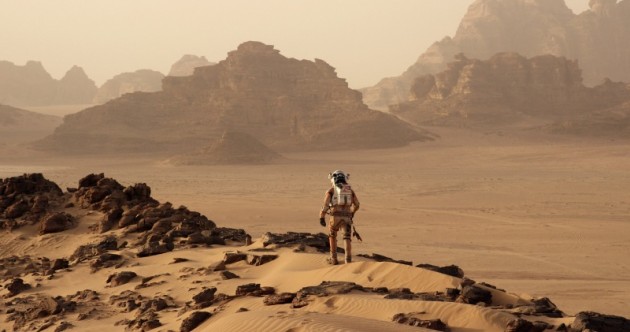
Isolation (and freedom) in Zachariah and The Martian
If one cannot be sure of the verifiable science in well-respected journals, what hope is there for mass culture’s representation of science? There is more genuine science in The Martian than one anticipates for a popular film. The Martian is a very beautiful film, focused on a mission to Mars and an astronaut crew of women and men that must depart due to an impending sandstorm, a colossal storm that overwhelms them, causing them to leave their botanist on the planet; it is intelligent and restrained but imaginative and seductive, even moving. Ridley Scott’s film The Martian (2015), based on Andy Weir’s book of the same name, and starring Matt Damon as the determined botanist, Jessica Chastain as a conscientious Mars space crew commander, and Chiwetel Ejiofor as a national space agency official; and the film is worth seeing and seeing again. The film begins swiftly in the midst of the customary crew work—checking equipment and collecting samples—when a revised storm alert interrupts the work and the camaraderie: the storm will be more massive than first predicted. (The great storm is one of the few exaggerations of what is possible in the atmosphere on Mars.) The crew begins to evacuate the planet, when botanist Mark Watney is hit by flying debris and presumed dead, his body impossible to find. The crew leaves him as they begin the return journey to Earth; and Mark Watney wakes in pain—Watney has been stuck with something that punctured his suit, and, luckily, the implement and his own blood have sealed the hole in his suit and prevented him from dying in the foreign atmosphere—an atmosphere that is cold and thin, mostly nitrogen, with little oxygen, and no significant air pressure; and with surrounding radiation. Mark Watney (a fit, muscular Matt Damon) tends to his own small but painful wound, performing an excruciating operation—anesthetizing the area around the wound, extracting a slug, and stapling the wound shut).
Many things can go wrong for the solitary botanist—an accident or flaw with the functioning of the equipment, the availability of water, and the quantity of food. Mark Watney (Damon) keeps an audio-visual log of what happens and what he thinks, a historical record (and it is a way for him to talk to us). Mark Watney looks through what was left behind among his colleagues’ things, trying to identify what is useful, and he estimates food storage and imagines food production using his own man-made fertilizer. “Mars will come to fear my botany powers,” he says. Watney prepares an indoor garden—planting potatoes. He creates a device for heating hydrogen and oxygen to make water for the plants.
Meanwhile, on the planet Earth, Vincent Kapoor, the director of Mars missions for NASA, the National Aeronautics and Space Administration, wants to proceed with his scientific work, requesting satellite time and preparing to go back to the planet to retrieve Mark Watney’s body. Vincent Kapoor (Chiwetel Ejiofor) faces bureaucratic obstruction. However, a young woman NASA observer sees evidence of Mark’s life—movement of equipment on Mars, and cleaned solar panels. NASA does not want to tell Mark Watney’s Ares III crewmates, now aboard the ship Hermes on their way back to Earth, that Watney is alive until the NASA staff devise a plan to rescue him. Watney’s intelligence and ingenuity as well as his sense of humor are staving off despair (Mark mocks his commander’s love of disco music, which he does listen to, even shaking his shoulders to the beat at one point). Watney wants to make his way to a Mars crater where he expects the next Mars mission, Ares IV, to be in four years’ time. Watney works to survive and get there, identifying and solving problem after problem, and he also enjoys the austere but strange and gorgeous landscapes; and there are moments of solitary beauty in the film—contemplative and elegiac, genuine poetry. Watney must master transportation and heating and does that by recycling equipment for movement and using radiation from a once-buried container for warmth.
“Everything astronauts need to survive—from the atmospheric system to forks to eat with—will have to be provided. When you start wrapping your mind around that, you recognize it’s a huge problem,” regarding getting human beings on Mars, commented Dave Lavery of NASA to Popular Science magazine (October 2015), near the beginning of a conversation about the film The Martian, with its director Ridley Scott and novelist Andy Weir, whose book was an online delight before being published in print by Crown in 2014. Dave Lavery, a scientist who worked on the Sojourner rover project, explained that NASA is planning flexible, light, small space suits, and wants to have the full Mars housing situation in place before the astronauts get there; and Lavery noted that the film The Martian, in telling an accessible and compelling story, could help people appreciate science and perceive the real nature of space travel. Andy Weir, who wrote the book The Martian, was aware of how simple many presentations of Mars exploration have been in the past, and Weir talked about balancing the needs of drama with scientific accuracy (actual space missions are designed to prevent drama), and Weir acknowledged that the originating event in the story—a great sandstorm—was an exaggeration, an invention, that The Martian atmosphere is not that volatile; and that he, Weir, minimized the actual danger of planetary radiation and the need for protection. Andy Weir, whose central character, a botanist, was conceived to address some of the most pressing problems of life on Mars, was impressed by the filmmakers’ consistent desire for accuracy. Ridley Scott, the director of Blade Runner (1982) and Prometheus (2012) as well as The Martian, admitted that he is an admirer of NASA, its astronauts, and its equipment, and has become a great admirer of science fiction, and he wanted to tackle the difficulties of Mars exploration, such as the provision of water and food, and show the discipline and vision it might take to survive there.
Why would human beings choose Mars as a destination, in the first place? There may have once been life on Mars, a planet orbited by asteroids of rock and metal: there could be “fossil evidence of life” in the planet’s dried riverbeds, notes astrophysicist Neil deGrasse Tyson in his book Space Chronicles: Facing the Ultimate Frontier (edited by Avis Lang, and published by W.W. Norton, 2012; page 40). Astrophysics is the science that studies and interprets the life and nature of galaxies and planets using the laws of physics and chemistry as standards for understanding and interpretation—and Neil deGrasse Tyson has accepted the possibility of life on Mars, and named Mars travel as a laudable goal. The prospect is almost enough to inspire a mission to find out: whereas a trip to the moon takes three days, a trip to Mars takes nine months, according to Tyson. Robots have sent back intriguing images of the planet’s surface. The reason to send a human being rather than a robot to investigate is “because the human brain is more intuitive about what it’s looking at than is the robot you’ve programmed,” Tyson has written (page 78). It is fascinating to be given a glimpse by the film The Martian into some of the practical and political practices that are involved in a space mission. Often space travel has been inspired—or, more precisely, justified—by military competition rather than scientific exploration; and, as it was the Russian Sputnik mission that inspired acceleration of the American space program, it may be competition with China that could lead to a mission by American astronauts to Mars, a goal that was advocated by George W. Bush, although the cost ($500 billion over twenty to thirty years) was thought prohibitive in a world without a recognized formidable nation-state enemy. President Barack Obama advocated a Mars mission as well—with the year 2035 as the do-date (rather than due-date). “Expensive projects are vulnerable because they take a long time and must be sustained across changeovers in political leadership as well as through downturns in the economy,” with the justification for the projects being not scientific knowledge but the enhancement of political power, national defense, and financial profit, as Neil deGrasse Tyson specifies in his anthology Space Chronicles (page 200). When something goes wrong—when a ship explodes, or a shuttle malfunctions, or an astronaut dies—it puts the whole space program in doubt.
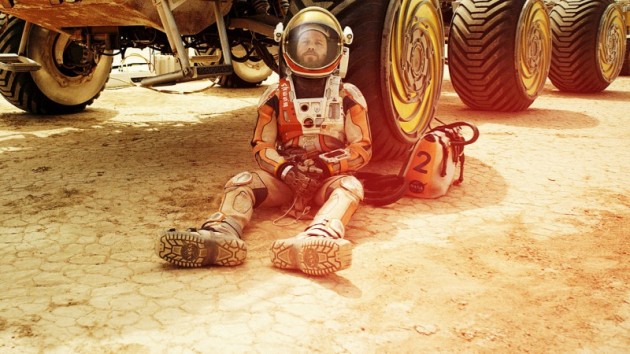
Thomas Edison’s company produced the motion picture A Trip to Mars in the year 1910; and it, very obviously, would not be the last film taking the planet Mars as a motivating object, and among the many others are Capricorn One, Conquest of Space, John Carter, Last Days on Mars, Martian Child, The Martian Chronicles, Mission to Mars, Race to Mars, Red Planet, and War of the Worlds. The most fantastic scenarios have given way to realism. In The Martian, the world is shocked that an American, Mark Watney (Matt Damon), could be left behind, and eager to know what will be done. In The Martian, Vincent Kapoor (Chiwetel Ejiofor) gives a press briefing about Mark Watney’s live status and the hope to bring him back—and NASA staff discuss Watney’s movements and try to ascertain why he is doing what he is doing and when supplies can be sent to him. Watney’s own efforts have yielded four-hundred thriving potato plants, while Watney tries to figure out how to make communication contact with NASA, using equipment left on Mars from a previous mission. How to survive? One achieves a pitiless clarity, a willful determination—and then one insists on one’s humanity, and remembers the humanity of others. Victor Kapoor, a man of spiritual faith (his parents were a Hindu and a Baptist) as well as of science, intuits from Mark’s movements that he is attempting to find old equipment on Mars to contact NASA, and Victor finds the corresponding equipment at the Jet Propulsion Laboratory. Watney uses camera movement and simple hand signs at first, then uses a code to communicate: hexadecimals, a system of numbers with a base of sixteen symbols, mostly zero to nine, representing those numbers and also alphabets A through F for signifying numbers ten through fifteen. It is thrilling to observe the scientists at work, although not always easy to translate excitement into understanding.
Mark Watney’s exuberance is tempered by anger when he learns that his old crewmates have not been told that he is still alive, a disapproval one of the NASA officials, Mitch Henderson (Sean Bean), shares—Mitch sends them a video notice. Something goes wrong at Watney’s Mars base, there is an accident, and his plants die—Watney has only the potatoes grown already to eat. NASA plans to accelerate its schedule to send a supply ship to him, but worry that it will not reach him in time before he is out of food. (Through all this there is worry about how what NASA officials, staff, and crews do—and any mistakes—will affect NASA’s public reputation. Public relations are important—and this acknowledgement reminds one that NASA is an agency, an embodiment of national power, but not national power itself.) When Watney’s crew does learn he is alive, they feel shock, and when they contact Watney, the exchange—with Martinez (Michael Pena) speaking and the commander (Jessica Chastain) nearby—is both mocking and loving. The film conveys the complexity of discipline and camaraderie that goes into the most serious of exceptional endeavors—and the resilience. Mark repairs the damaged habitat with plastic tarp and tape—a surprisingly effective tactic (also, a bit of foreshadowing of a necessary resource—later, with NASA’s guidance, Mark will attempt to use a ship to get off the planet, lightening it by getting rid of all kinds of equipment and parts of its shell, covering the opening with tarp).
An eccentric astrophysicist, nerdy, self-contained, funny, Rich Purnell, devises a plan to use the supply ship to pick up Mark Watney. Rich (Donald Glover), charming and inventive, becomes useful when the first supply ship—due to flawed analysis, and lack of scientific testing—is not able to fulfill its complete mission. NASA authorities have reservations about the Purnell plan. Mark’s Ares III colleagues, the crew that was on its way back to Earth, accept Rich’s proposal, though it may have a negative impact on their own careers and even endanger their lives. (David Bowie’s song “Starman” accompanies scenes of preparation for the rescue mission—in offices, labs, home, and space.) The rescue mission becomes one of international concern.
The Martian is an efficient and intelligent as well as gorgeous and entertaining film—no doubt, one of the better science fiction films. Neil deGrasse Tyson has bemoaned some of the errors and cliché in other, previous science fiction films, including the misrepresentation of basic science and the insistence of humanoid aliens: in Tyson’s commentary “Hollywood Nights,” published on pages 327 through 334 in Death by Black Hole and Other Cosmic Quandaries (W.W. Norton, 2007), in addition to noting the backward representation of real constellations on the three-acre ceiling canvas of Manhattan’s Grand Central Station—and the reversed sunset presented as a sunrise in the opening credits of the television soap opera As the World Turns—Neil deGrasse Tyson draws attention to the scientific errors in several films, including a black hole depicted as a dank cave in Gary Nelson’s Black Hole (released 1979, though Tyson gives the date as 1977); the inaccurate night sky in the drowning scene in James Cameron’s Titanic (1997), apparently later corrected after Tyson’s personal complaint to Cameron; and Jodie Foster’s bad math when estimating the numerical likelihood of intelligent life on other planets in Contact (1997). The celebrated African-American astrophysicist, Tyson, later, would criticize the science in the popular film Gravity (2013), too, but he said that The Martian got the crucial science right.
Of course, the beauty of the landscapes in the film The Martian is engaging, and the science worth consideration, and the story thrilling, but it is the human element that is moving: The Martian, like Z for Zachariah, is about human survival—but, more than that, the two cinematic stories focus on what is inside of each person that is worth keeping, and worth building on: what kinds of emotions and ideas and choices extend life and make relationships and society possible? The striking thing about Z for Zachariah and The Martian is that they clear away most of the attributes of civilization, forcing lone individuals to sustain themselves using basic intellectual rudiments and resolute spirit. Human beings are forced to consider their own nature and that of the surrounding world.
(Submitted March 2016)


